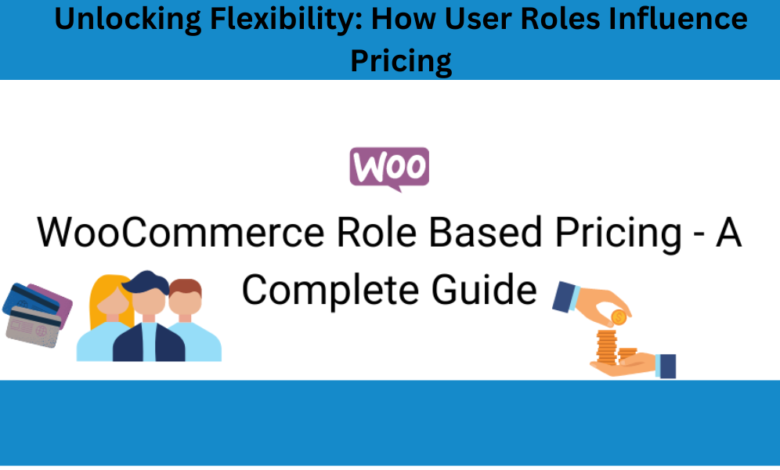Unlocking Flexibility: How User Roles Influence Pricing

The secret to success in today’s dynamic corporate environment is adaptability. Offering flexible pricing structures can be a game-changer whether you run a software company, a service provider, or an e-commerce site. Woocommerce role based pricing are one of the key elements in establishing price flexibility. A user’s level of access, functionality, and power within a system or platform is determined by their user roles. Businesses may adjust their solutions to match the different needs of their consumers and maximize income streams by understanding how user roles affect pricing.
The Significance of User Roles
User roles play a pivotal role in software and service-based industries. They are not just a way to control access; they also define the customer’s experience and influence the pricing strategy. A user role typically falls into one of three categories: administrators, power users, and standard users. Let’s delve deeper into these roles and how they impact pricing.
Administrators:
Administrators have the highest level of access and control within a system. They can configure settings, manage users, and often have a comprehensive view of the platform’s functionalities. In the context of pricing, administrators are typically charged a premium since they require advanced features and capabilities to efficiently manage the system.
Power Users:
Power users are experienced individuals who need additional features and functionalities compared to standard users. They may require specialized tools or enhanced permissions to perform their tasks efficiently. Power users often fall in the mid-tier pricing range, as they need more than the basic package but not the full suite of features offered to administrators.
Standard Users:
Standard users are the most common type of users and often form the bulk of a platform’s user base. They have access to essential features and functionalities necessary for their tasks. Standard user pricing is usually the most affordable, making it accessible to a wide range of customers.
How User Roles Impact Pricing
Now, let’s explore how user roles influence pricing strategies in different industries:
1. Software as a Service (SaaS):
In the SaaS industry, user roles can significantly impact pricing models. SaaS companies often offer tiered pricing structures to cater to users with varying needs. Here’s how user roles are typically reflected in SaaS pricing:
User-Based Pricing:
SaaS companies commonly charge on a per-user basis. Administrators and power users are charged at a higher rate due to their need for advanced features and control. Standard users, on the other hand, pay a lower fee as they only access essential functionalities.
Feature Tiers:
Many SaaS providers offer different feature tiers that align with user roles. For instance, a basic tier may be suitable for standard users, while a premium or enterprise tier offers advanced features for administrators and power users. Each tier comes with a corresponding price point.
Customization:
Some SaaS providers allow customers to customize their plans based on user roles. This flexibility ensures that businesses only pay for the features and access levels they require, making pricing more tailored and cost-effective.
2. E-Commerce:
In the e-commerce sector, user roles can impact pricing in several ways:
Membership Pricing:
E-commerce platforms often offer premium membership programs that grant users special privileges, such as discounts, early access to sales, and exclusive content. These memberships come at a cost and are typically structured to cater to power users and loyal customers.
Wholesale Pricing:
For e-commerce platforms that serve both individual consumers and wholesale buyers, user roles determine pricing. Wholesale buyers, who make bulk purchases, usually receive discounted pricing compared to standard users.
Tiered Discounts:
Some e-commerce platforms offer tiered discounts based on user roles and purchase history. Frequent buyers or high-value customers may qualify for larger discounts, encouraging loyalty and repeat business.
3. Service Providers:
For service-based businesses, user roles can influence pricing in the following ways:
Account Types:
Service providers often offer different account types with varying levels of service. Premium or business accounts are priced higher and come with additional services or support, while standard accounts offer basic service at a lower cost.
User Access:
In industries like consulting or project management, user roles can dictate who has access to certain data or reports. Clients or team members with more extensive access may incur higher charges.
Add-Ons and Upgrades:
Service providers frequently offer add-on services or upgrades tailored to specific user roles. For example, a marketing agency may offer advanced analytics as an add-on for power users who require in-depth insights.
Benefits of Tailoring Pricing to User Roles
Increased Customer Satisfaction:
By offering pricing plans aligned with user roles, businesses can ensure that customers only pay for what they need. This transparency enhances customer satisfaction, as users feel they are getting value for their money.
Higher Retention Rates:
Tailored pricing plans can promote customer loyalty. When users see that their specific needs are being addressed and that their roles are considered in pricing, they are more likely to stick with the service or platform.
Optimized Revenue Streams:
By effectively segmenting users based on their roles, businesses can optimize revenue streams. They can capture a wider market by offering affordable plans for standard users while maximizing revenue from power users and administrators who require premium features.
Competitive Advantage:
Businesses that offer flexible pricing based on user roles can gain a competitive edge. They can adapt to market changes quickly and accommodate the evolving needs of their customers.
Challenges in Implementing User Role-Based Pricing
While user role-based pricing offers numerous benefits, it’s not without its challenges:
Complexity:
Managing multiple pricing tiers and user roles can be complex. Businesses must carefully define user roles and ensure that customers are correctly assigned to the appropriate pricing plan.
Communication:
Clear communication about pricing plans and the value they provide to each user role is crucial. Misunderstandings or confusion can lead to customer dissatisfaction.
Data Management:
Maintaining accurate user data, tracking usage, and ensuring that users are billed correctly require robust data management systems.
Pricing Changes:
When introducing or adjusting pricing plans based on user roles, businesses must communicate these changes effectively to existing customers to prevent churn.
Case Studies: Successful Implementation of User Role-Based Pricing
Slack:
Slack, a popular team collaboration platform, offers a free version for standard users with limited features. As users’ needs grow, they can upgrade to premium plans with additional features and administrative controls. This tiered pricing model has helped Slack capture a wide user base while generating revenue from businesses and organizations requiring advanced functionalities.
Adobe Creative Cloud:
Adobe offers its Creative Cloud suite with different pricing plans based on user roles. Individual users pay a lower subscription fee, while businesses and educational institutions can access specialized plans tailored to their needs. This approach allows Adobe to cater to a diverse customer base while maximizing revenue.
Conclusion
User roles are a critical factor in shaping pricing strategies across various industries. By tailoring pricing plans to different user roles, businesses can enhance customer satisfaction, boost retention rates, optimize revenue streams, and gain a competitive edge. However, implementing user role-based pricing requires careful planning, effective communication, and robust data management. When executed successfully, it can unlock the flexibility needed to thrive in today’s ever-changing business landscape, ensuring that businesses and customers alike benefit from the power of tailored pricing.



